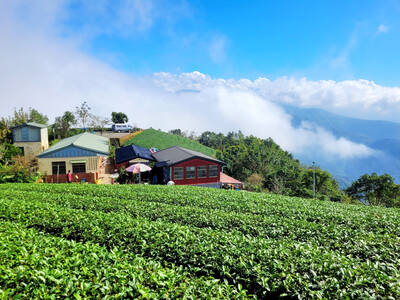When David Janes and Stomu Miyazaki launched a nonprofit a few years back aimed at teacher exchanges between the US and Asia, Taiwan wasn’t their first choice to inaugurate the program — it was Japan.
But Miyazaki, an architectural designer born in Japan, developed a special fondness for the island nation, where he had spent time designing a house in Kaohsiung.
“It felt like home,” he told the Taipei Times.

Photo: Chris Fuchs
That experience helped plant the seed to send a small cohort of American teachers to Taiwan this summer as part of a 10-day program conceived by EngageAsia, a US-based nonprofit.
The project aims to educate the teachers about Taiwan’s history, culture and society, while deepening their understanding of the Asia-Pacific region — all knowledge they will bring back to the classroom and share with their American students.
“When you’re thinking about northeast Asia, at least when I look at the field, there’s very few programs that take teachers to Taiwan,” Janes said. “And I think it’s something that a lot of teachers don’t think about at all.”
SOLD ON TAIWAN
Janes, whose day job is serving as director of foundation grants and assistant to the president of the United States-Japan Foundation, a nonprofit, said there are many programs that bring educators to China and Japan, and to a lesser extent Korea.
But after visiting Taiwan for the first time in October last year for a planning trip, he said he was sold on beginning the program there.
“Geographically, Taiwan is between Japan and China, but in a way it almost felt like culturally in-between,” Janes said.
Miyazaki, who taught interior design for eight years at an American university, said Taiwan could serve as an important hub when they expand their program to other Asian countries, including in Southeast Asia.
“This makes perfect sense rather than doing US-Japan,” Miyazaki said.
For their first Taiwan trip, Janes and Miyazaki said they wanted to start small with a handful of teachers from public schools in Westchester, New York. Following some seminars in the US, the group is expected to leave for Taiwan in late July, staying in Kaohsiung and Taipei.
Each teacher will pay US$2,000, a fee reduced from roughly US$6,000 as a result of fundraising and donations, including contributions from Janes and Miyazaki, the pair said. Janes said they had written two grant proposals to help fund the program but never heard back.
In Kaohsiung, the teachers will live with homestay families and have personal interpreters, according to Janes and Miyazaki. There they will research subjects they’ve chosen, among them culinary arts and people and daily life, and bring this material back to the American classroom.
The educators will also be armed with video cameras to record their activities, Miyazaki said.
INDEPENDENT EXPLORATION
Unlike some US-Asia programs where teachers stick together for much of the time, EngageAsia will aim to get them out on their own, Janes and Miyazaki said.
“We want to treat them like scholars instead of us sort of shepherding them around,” Janes explained.
That means pushing the educators out of their comfort zones, for instance getting them to secure their own meals, Miyazaki added, in a place where they don’t necessarily speak the language.
“It’s going to be a little bit tough … but that’s how you learn the different cultures,” he said. “To me, it’s the only way.”
After Kaohsiung, the group is slated to spend time in Taipei, participating in a design thinking workshop with high school teachers. Design thinking is a method of problem solving that seeks to identify alternative strategies and solutions that may not be immediately obvious.
Among other things, teachers during these workshop sessions will brainstorm ways to share what they learn with students back home in a manner that helps them feel and experience them, according to EngageAsia.
Janes added that an important component of the program is also to ensure teachers remain connected with the nonprofit.
“Wouldn’t it be great if we could get out of this sense of the only thing we’re trying to do is train American teachers to bring in content about Taiwan and somewhere else, [but] instead we’re also trying to have them foster ties with teachers from another country, real friendships that can grow?” he said.
This part will prove vital for EngageAsia in coming years, as a group of Taiwanese teachers is expected to travel to the United States in 2019 for a similar purpose.
ANGERING CHINA?
Janes and Miyazaki, neither of whom draws a salary from EngageAsia, noted that after Taiwan they plan to extend their nonprofit’s reach to Japan and Korea, as well as other Asian countries, which may include Singapore, Malaysia and Indonesia.
Both men did acknowledge the potential blowback that could arise from choosing Taiwan — viewed by China as a renegade province that must be reunited someday, by force if necessary — as its launching-off point for their program.
“I think it’s complicated, especially when you bring in China or Korea,” Janes said. “There are so many emotions over World War II ... there are territorial disputes, there are very different political structures.
“My hope is that we can make it clear to people that our goal is simply to provide teachers with an opportunity to learn about these other countries, to improve their own teaching, to improve opportunities for kids in their classroom to learn about these other countries.”

Every now and then, it’s nice to just point somewhere on a map and head out with no plan. In Taiwan, where convenience reigns, food options are plentiful and people are generally friendly and helpful, this type of trip is that much easier to pull off. One day last November, a spur-of-the-moment day hike in the hills of Chiayi County turned into a surprisingly memorable experience that impressed on me once again how fortunate we all are to call this island home. The scenery I walked through that day — a mix of forest and farms reaching up into the clouds

With one week left until election day, the drama is high in the race for the Chinese Nationalist Party (KMT) chair. The race is still potentially wide open between the three frontrunners. The most accurate poll is done by Apollo Survey & Research Co (艾普羅民調公司), which was conducted a week and a half ago with two-thirds of the respondents party members, who are the only ones eligible to vote. For details on the candidates, check the Oct. 4 edition of this column, “A look at the KMT chair candidates” on page 12. The popular frontrunner was 56-year-old Cheng Li-wun (鄭麗文)

“How China Threatens to Force Taiwan Into a Total Blackout” screamed a Wall Street Journal (WSJ) headline last week, yet another of the endless clickbait examples of the energy threat via blockade that doesn’t exist. Since the headline is recycled, I will recycle the rebuttal: once industrial power demand collapses (there’s a blockade so trade is gone, remember?) “a handful of shops and factories could run for months on coal and renewables, as Ko Yun-ling (柯昀伶) and Chao Chia-wei (趙家緯) pointed out in a piece at Taiwan Insight earlier this year.” Sadly, the existence of these facts will not stop the

Oct. 13 to Oct. 19 When ordered to resign from her teaching position in June 1928 due to her husband’s anti-colonial activities, Lin Shih-hao (林氏好) refused to back down. The next day, she still showed up at Tainan Second Preschool, where she was warned that she would be fired if she didn’t comply. Lin continued to ignore the orders and was eventually let go without severance — even losing her pay for that month. Rather than despairing, she found a non-government job and even joined her husband Lu Ping-ting’s (盧丙丁) non-violent resistance and labor rights movements. When the government’s 1931 crackdown